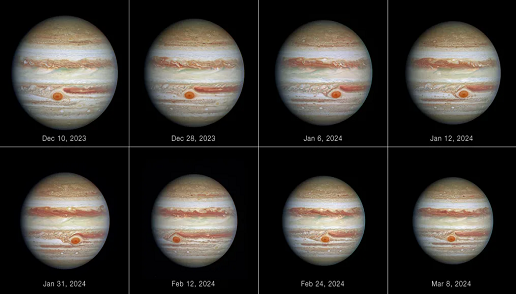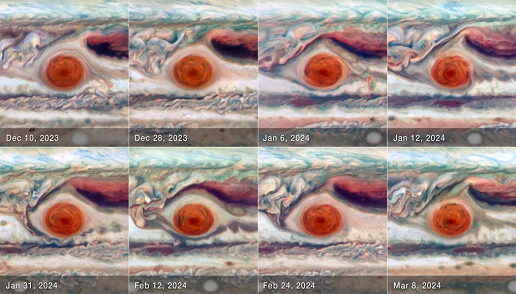New observations of Jupiter’s Great Red Spot captured by the Hubble Space Telescope reveal that the 190-year-old storm moves like gelatin, changing shape like a squeezed stress ball. These observations, taken over 90 days from December to March, show that the storm’s size and motion oscillate unexpectedly. The Great Red Spot, an anticyclone in Jupiter’s southern hemisphere, is the largest storm in the solar system, big enough to fit Earth inside it. While previously believed to be stable, the storm is shrinking and jiggling, with its shape becoming skinnier or fatter over time.
Researchers published these findings in The Planetary Science Journal, presenting them at the 56th annual meeting of the American Astronomical Society’s Division for Planetary Sciences. Amy Simon, the study’s lead author, explained that Hubble’s high-resolution images allowed scientists to observe that the storm is simultaneously squeezing in and out while speeding up and slowing down. Tracking changes in the storm can help scientists better understand processes taking place in Jupiter's atmosphere. NASA/ESA/STScI/Amy Simon
Tracking changes in the storm can help scientists better understand processes taking place in Jupiter's atmosphere. NASA/ESA/STScI/Amy Simon
The Great Red Spot’s cold center creates thick clouds due to condensation of ammonia and water. The research also found the presence of phosphine gas, possibly linked to the storm’s iconic red color.
The shrinking storm is expected to reach a stable size, reducing its wobble. Ongoing observations will help scientists better understand the processes in Jupiter’s atmosphere and could offer insights into weather systems on exoplanets. The study underscores the importance of long-term monitoring for revealing hidden patterns in complex atmospheric systems like Jupiter’s Great Red Spot.






